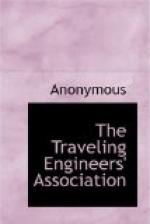5. Q. How is the increased boiler capacity obtained?
A. A boiler will evaporate a certain amount of water into steam and if part of the steam is lost by condensation, only that remaining is available for running the engine. Superheating eliminates the losses, thereby increasing the available useful steam. Further, superheating increases the volume of a given weight of steam, thereby reducing the consumption of steam required to develop a certain power and consequently increases the capacity.
6. Q. How is a more powerful engine obtained?
A. By reason of the increased boiler capacity an engine may be worked farther down before a steam failure occurs.
7. Q. What type of fire tube superheater is in most general use in locomotive service?
A. The top header fire tube type, known as the “Schmidt Superheater.” A system of units located in large flues through which the steam passes on its way from the dry pipe to the steam pipes, and a damper mechanism which controls the flow of gases through the large flues.
8. Q. Describe the construction and location of the header.
A. The header is a simple casting, divided by partition walls into saturated and superheated steam passages. It is located between the dry pipe and the steam pipes, the same as the nigger head in a saturated locomotive. The dry pipe is in communication with the saturated steam passages and the steam pipes with the superheated steam passages and these are in communication with each other through the superheated units.
9. Q. Describe the construction of superheater units and their connection to the header.
A. The units are composed of four seamless steel pipes, connected by three return bends. Of the four pipes, two are straight and two are bent upward and connected to the header by means of a clamp and bolt; one end of the unit is in communication with the saturated steam passage and the other with the superheated steam passage in the header casting.
10. Q. Trace the flow of steam through the top header fire tube superheater.
A. When the engine throttle is open, saturated steam passes through the dry pipe into the saturated steam passage of the header casting. From this passage it enters one end of the unit, passing backward toward the fire-box, forward through one of the straight pipes and the front return bend, backward through the other straight pipe to the back return bend, and forward through the bent pipe and upward into the superheater steam passage of the header, from which it enters the steam pipes and is carried to the steam chest.
11. Q. What should be the position of throttle valve when running a superheater locomotive?
A. The engine should always be run with as wide open throttle as the conditions will permit, regulating the steam admission to the cylinders according to work to be performed.
12. Q. What should be the position of throttle while drifting?




